Street Foods on Foot
and at a Home in Istanbul
A Tour of Traditional Culinary
Treats
Article and photos by
Lies Ouwerkerk
Senior
Contributing Editor
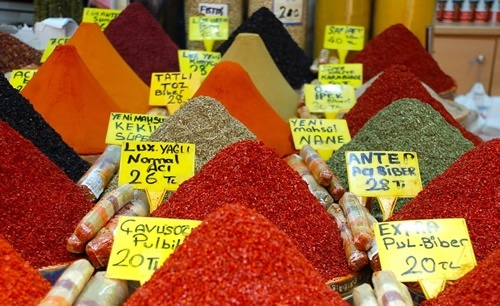
|
|
Spice market in
Istanbul.
|
“Tell me what you eat, and I’ll tell
you what you are,” wrote gastronome Brillat-Savarin in 1825
in his "Physiology of Taste." As a lover
of anything food, and eager to learn about people and their
customs, that quote immediately popped up in my mind when
I got "stranded" in the Turkish capital for three
days, on my way from Tajikistan to Georgia. So as soon as
I had secured a place for the night, I signed up online
for three different walking food tours with "Istanbul
on Food," a company that boasts the sampling
of a large variety of traditional Turkish foods while exploring
the backstreets of several vibrant neighborhoods on foot,
in small groups of maximum six participants.
Taksim Square, situated in the modern
center of Istanbul’s European part, and easily accessible
by metro or bus, was the starting point for the “Twilight
at Taksim” tour on my first night. I met with Turkish guide
Korhan and a group of four jolly British businessmen at
the iconic confectioner Hafiz Mustafa, the oldest pastry
shop in Istanbul, founded in 1864. It was difficult to resist
their dazzling assortment of sweets, but we were warned
to keep enough space for the many more foods to come, including
some similar heavenly desserts.
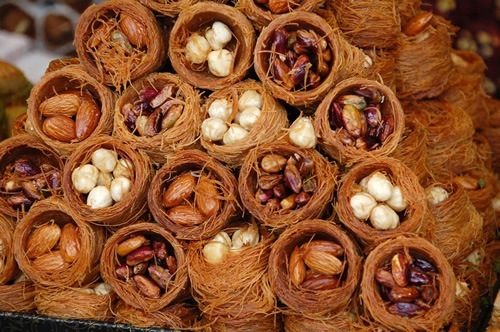
|
|
Sweets at Hafiz
Mustafa.
|
Meat
To begin, we tried various meats at
street food stalls, traditional restaurants, and little
eateries only locals seem to know about. For instance, the meshur
islak hamburger, a very moist beef hamburger coated
in hot tomato sauce, and the most popular street food in
Istanbul. You can also find the tantuni,
a flat bread wrap originally from Mersin in Southern Turkey,
filled with cooked, and then stir-fried, spiced ground beef,
and served with onions, pickled hot pepper, a squeeze of
lemon, and herbs.
We indulged in delicious kebapi varieties,
including the dönerkebap (deboned, compressed lamb
and beef meat, roasted on a vertical spit, shaved in very
thin slices with a long knife, and served with hot pepper
and tomato sauce). We sampled the Iskender kebap (a dönerkebap of
lower fat content, and named after Iskender Efendi who invented
the vertical cooking kebab). We devoured the cag kebap (slices
of marinated lamb and tail fat roasted on a rotating horizontal
spit, and originating from Erzurum in Eastern Turkey), and
the skewer kebab from cuts of lamb and chicken, grilled
over flames.
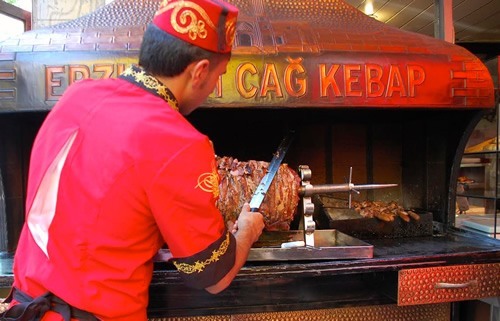
|
|
A street vendor
making cag kebap.
|
And last but not least, we ate köfte,
meatballs made of fried minced lamb meat, coated in bulgur
wheat, and shaped in croquette-style (içli köfte). The
“raw” variety is made without meat, simply made of bulgur
wheat, tomato, onion, hot pepper, and parsley, served in
a lettuce cup (çig köfte).
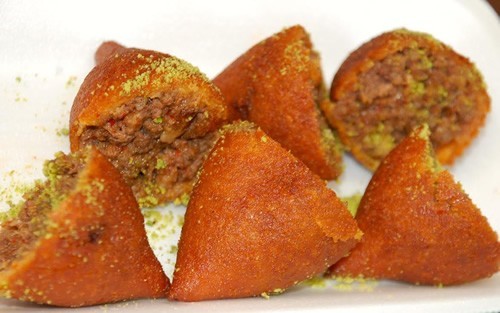
|
|
Kofte with
meat (delicious in croquette-style without as well).
|
Drinks
The accompanying drink for all these
dishes would invariably be ayran, a salty yoghurt-water
mixture, served in copper cups with a huge layer of foam
on top.
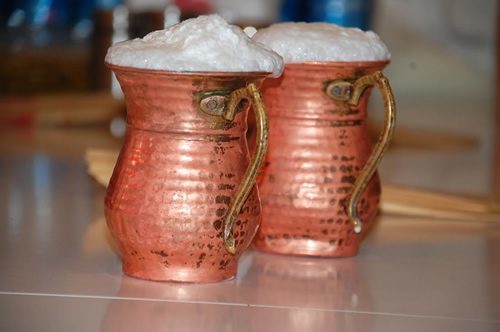
|
|
Ayran.
|
While crossing a section of Istanbul’s
Red Light District and being surprised by a sudden downpour
of rain and hail (luckily, vendors with cheap plastic umbrellas
popped up at the drop of a hat), we took shelter inside
one of the many watering holes lining the backstreets of
the Nevizade district, where Korhan taught us how to drink raki.
Raki is the unofficial national
alcoholic (45%) drink of Turkey, made of twice-distilled
grapes and aniseed, often diluted with chilled water, preferably
accompanied by meze (appetizers) such as the accompanying
feta cheese and melon. Raki is served in narrow
drink glasses (kadeh). Following Turkish tradition,
we clinked the bottoms of our glasses to bring a toast.
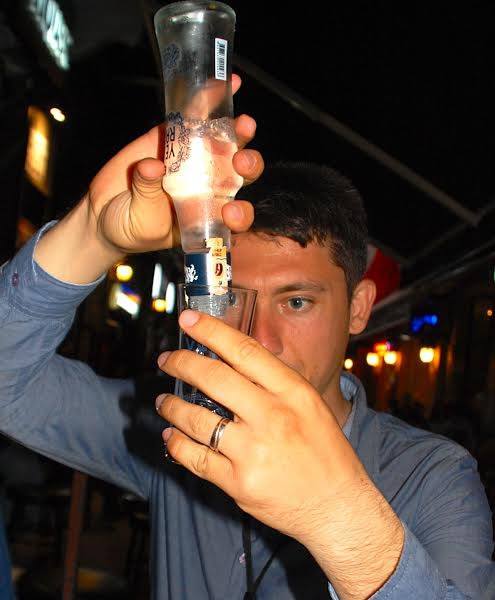
|
|
Korhan dilutes super
strong raki with water.
|
Tripe
A must-do in Istanbul is eating in a
traditional paçacilar, a tripe restaurant where
you can taste the classic iskembe soup 24 hours
a day. It is made of grilled lamb tripe and served with
garlic-lemon sauce. Although the soup was initially introduced
to Turkey by residents from Greek and Armenian descent, iskembe is
today known as late night partygoers’ and early morning
prayers’ food in Turkey.
I knew what the soup consisted of, and
although the looks of it were not really tantalizing, I
did give it an honest try. Alas... not for me!
Desserts
Turkey is world-famous for its desserts,
and we tried many. More than once, we savored different
varieties of absolutely delicious, flaky, buttery, fresh baklava, the
most well known of all Turkish desserts, made of many layers
of filo dough. The colorful varieties of lokum (Turkish
Delight) — once the most important gift for special
occasions during the Ottoman Empire such as births, weddings,
and coming of age ceremonies — could also be found in
practically every pastry shop, together with halqom,
cookies stuffed with lokum. The cream of the crop
were the kunafe, a cheese pastry soaked in sweet
syrup and topped with pistachio nuts, and sütlaç, a
baked rice pudding, made from fresh whole milk, topped with
dried nuts, apricot, figs, banana, and jam or honey, and
served in a clay ramekin.
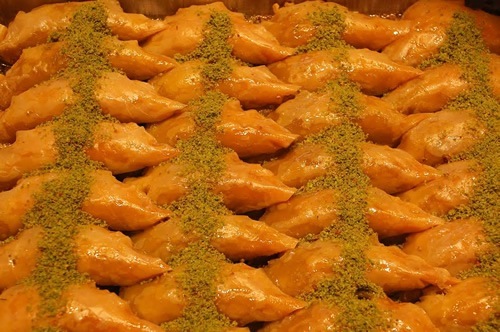
|
|
Baklava.
|
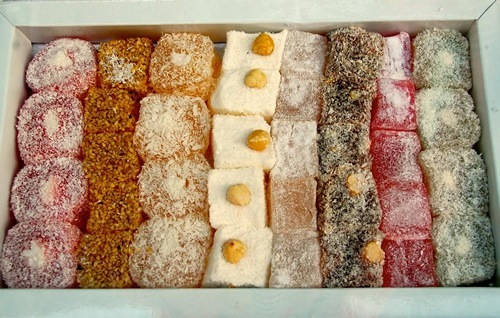
|
|
Turkish Delight
is sweet.
|
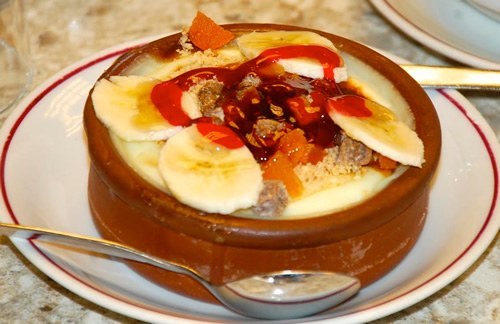
|
|
Sütlac.
|
Traditional Turkish Breakfast
Needless to say, I refrained the next
morning from any breakfast until meeting Korhan and the
other participants (a family with three teenage daughters)
for the day tour, “Taste of Two Continents,” which started
at the big spice bazaar in the Eminönü quarter on the European
side of Istanbul.
At the over 350-year-old bazaar, also
called "Egyptian Bazaar" (spices coming from South
East Asia and India would arrive here via Egypt), amid strings
of dried peppers and eggplants, beauty products, aphrodisiacs,
and colorful spices heaped in mini-volcanoes, Korhan sought
all the ingredients necessary for a traditional Turkish
breakfast. Among them were tulum (goat cheese
ripened in a goatskin casing for about 6 months); pastirma (dried
meat, very thinly sliced), eggs, peppers, olives, tomatoes; kaymak (clotted
buffalo cream); and a bag of simit (similar to
bagels, coated with sesame seeds and grape molasses, Turkey’s
most popular snack food, and usually sold by street vendors).
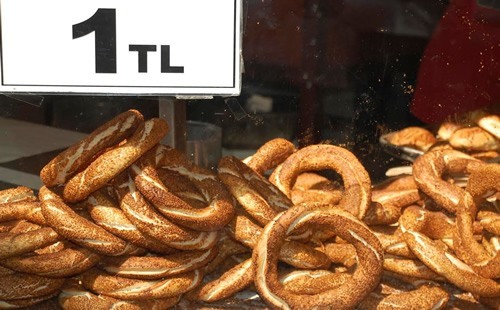
|
|
Simit.
|
Turkish Tea
Seated on the terrace of a little teahouse
and facing the New Mosque Yeni Cami with its 66 domes and
semi-domes in pyramidal formation, we prepared our own breakfast
while Korhan explained to us the important role tea plays
in daily life throughout Turkey.

|
|
Yeni Kapi Mosque.
|
Not only is Turkey world’s fifth largest
tea producer (cultivated in the Eastern Black Sea region),
but it is also the largest tea per capita consumer in the
world. Turks love it, and drink many cups a day!
Turkish tea is brewed in a double teapot
or samovar. Water is boiled in the lower pot and poured
over the tealeaves in the upper pot. Then the strong brew
is served in a small, tulip-shaped glass on a saucer with
some sugar cubes (no milk!), and diluted with hot water
for the right deep-red color and perfect taste.
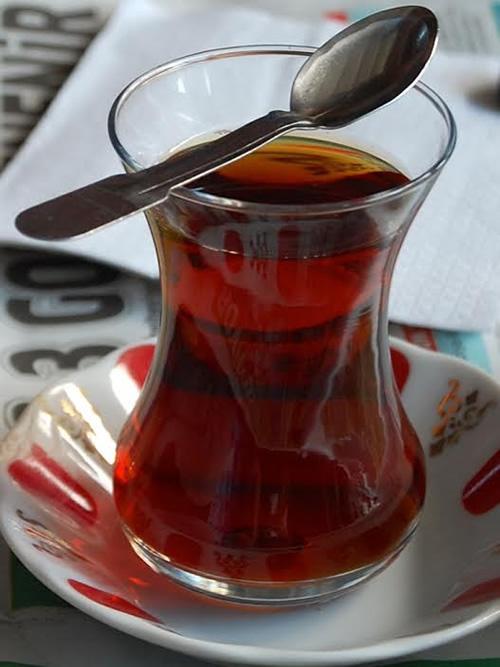
|
|
Turkish tea.
|
Gastronomy at the Anatolian Side
of Istanbul
After breakfast, the tour continued
across the Bosporus on the Anatolian side via a ferry ride.
There were magnificent views of the old city center of European
Istanbul. We arrived in the bustling district of Kadiköy,
an Anatolian port situated on the northern shore of the
Sea of Marmara. The half hour crossing was certainly worth
the visit, as Kadiköy has a wonderful street food market
with fresh fish, fruits, and vegetables, and hosts tantalizing
candy and pastry shops, excellent lokantas (simple
restaurants), as well as superb delicatessens and pickle
stores.
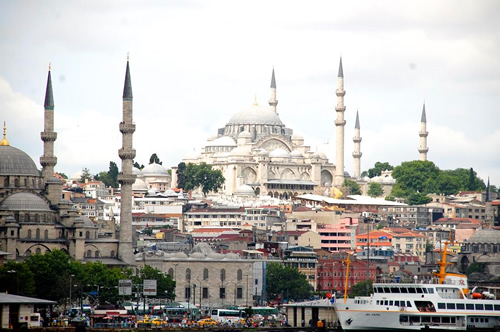
|
|
On a ferry to Kadiköy.
|
We sampled candies of sweetened walnut,
olives, and eggplant at Café Erol, the oldest candy shop
in Istanbul (1807). We sipped their famous gelinçik
serbet, a sherbet prepared from red poppy petals. We
had a lunch platter of various cold and hot meze at
Çiya Sofrasi, which included lamb meatballs in cherry sauce,
stuffed dried eggplant, and bulgur-stuffed tomatoes. We
ate the traditional kellepaça at Kinyon, a delicious
soup of boiled cow feet, with an optional addition of arugula
and garlic sauce. Korhan tried, in vain, to interest me
in tripe again, this time in the form of kokoretsi (rolls
of sheep intestines), roasted on a wood fire, and served
in a bun, seasoned with oregano, red pepper, lemon, and
oil.
The feast was topped off at the end
of the day by a dondurma (Turkish ice cream) platter
at Mado, the best ice cream parlor in all of Turkey. There,
next to a cup of hot salep (a drink
made from wild orchid tubers, rosewater, and hot milk),
they served sliced ice cream of a gum-like dense consistency
(made of milk, sugar, mastic, and salep), which
one eats with fork and knife.
Culinary Backstreets Around the
Grand Bazaar
Although there were some food overlaps
with the previous tours, such as baklava and kebabs, the
third tour "Flavors of the Old City," which took
place in the backstreets of the old town between the spice
market and the Grand Bazaar, still offered surprises.
In the company of yet another family
of five, I tasted savory baklavas with feta cheese, spinach,
parsley, and ground meat at Süllüoglu’s, where they soften
the filo sheets in boiling water before layering them. In
a small lokanta, we tried spicy lentil soup, Turkey’s
favorite entrée, and chickpea pilav with chicken, Istanbul’s
well-known street food. At delicatessen shop Namli Gurme,
we ate dolma, grape leaves stuffed with pepper,
onion, tomatoes, and pine nuts. We had katmer,
an ancient pastry from Anatolia filled with pistachios and
clotted cream, at a sidewalk café. At Higipolu’s, a long-time
Turkish Delight shop, we were taught how the sugary lokum had
been prepared for centuries.
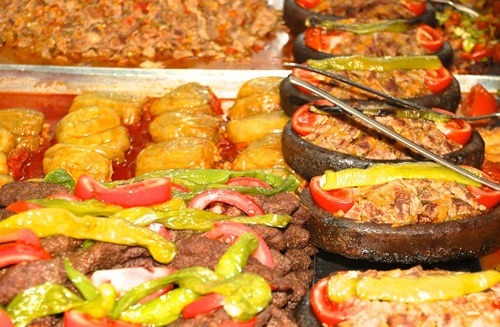
|
|
Sample treats at
a delicatessen.
|
Turkish Coffee
Coffee has always been an integral part
of the hospitality and friendship culture in Turkey. We
sat down at one of the low tables and stools one can see
everywhere in the country, to enjoy some freshly brewed
coffee together. Roasted and ground coffee beans were cooked
with water and sugar in a cezve, a tiny coffee
pot made from copper or brass, over a very low heat. After
the foam that started to form was removed, the coffee mixture
was heated to boiling point and then served in some very
small cups from which we sipped slowly on one side only.
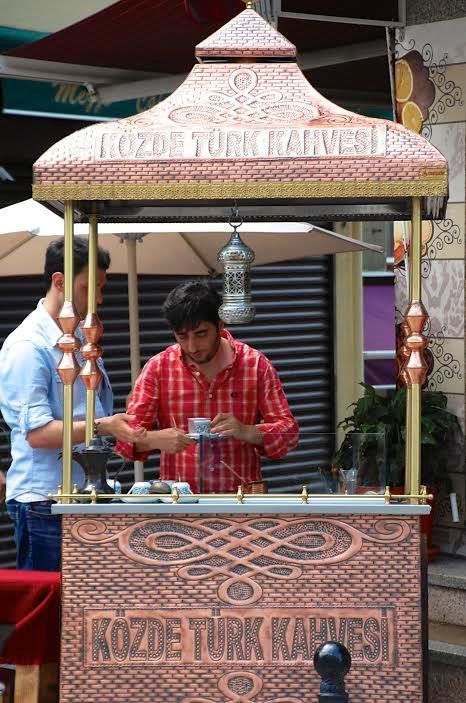
|
|
A typical coffee
stall in Istanbul.
|
Once the coffee had been finished, fortune
telling (fal) followed according to a centuries-old
ritual: the cup had to be quickly turned counterclockwise
at chest level, with the saucer on top. Then the cup was
turned upside down onto the saucer, and once cooled off,
Korhan interpreted with much drama and “knowledge” the shapes
that had been formed, both on our saucers and in our cups.
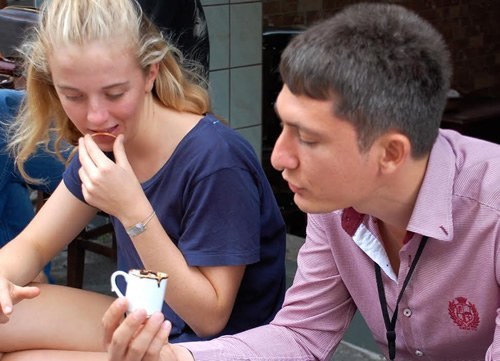
|
|
Korhan's coffee
reading.
|
Lunch at a Local Home
The absolute highlight of this tour
was undoubtedly the lunch at the private home of a local
Turkish woman named Muhlise. Not only were we blown away
by her hospitality and the perfect lunch she served us (mercimek
çorbasi, a lentil soup with vegetables, and pilav with karniyarik,
a dish of stuffed eggplant with a mixture of ground meat,
onion, tomatoes, peppers, and parsley), but she also treated
us to some beautiful Turkish love songs. The meal was a
most worthy closure to a highly enjoyable culinary journey,
which I would never have experienced on my own.
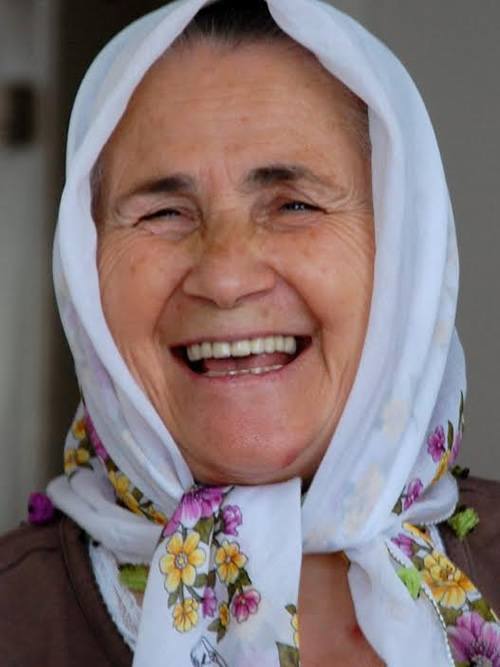
|
|
Hostess Muhlise
in Istanbul.
|
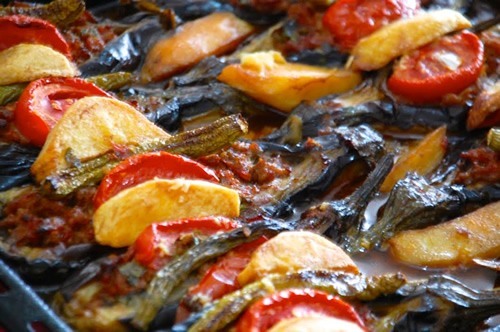
|
|
Hostess Muhlise's karniyarik.
|
Contact Yummy Istanbul for more details about the tours.
Lies
Ouwerkerk is originally from Amsterdam,
The Netherlands, and currently lives in Montreal,
Canada. Previously a columnist for The Sherbrooke
Record, she is presently a freelance writer and
photographer for various travel magazines.
|
